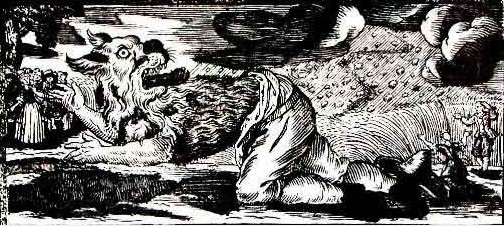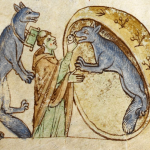From THE BOOK OF WERE-WOLVES
by SABINE BARING-GOULD
Smith, Elder & Co., London
1865
Lycanthropy is closely related to cannibalism. The nightly activities of a werewolf were believed to be hunt, murder, and eat their victims. Some werewolf stories tell that their purpose was to kill and devour entire herds of sheep or similar animals. Even though these beasts did not possess a particular diet, they were believed to prefer tender flesh, as of children (The original version of Little Red Riding Hood is a good example to understand the relation between cannibalism and lycanthropy).
Man, naturally, in common with other carnivora, is actuated by an impulse to kill, and by a love of destroying life. This tendency is widely diffused; it exists in children and adults, in the gross-minded and the refined, the well-educated and the ignorant, in those who have never had the opportunity of gratifying it, and those who gratify it habitually, in spite of morality, religion, laws, so that it can only depend on constitutional causes. Moreover, this taste for blood can also coexists with more civilized feelings. This tendency, however, exists in different degrees. In some it is manifest simply as indifference to suffering, in others it appears as simple pleasure in seeing killed, and in others again it is dominant as an irresistible desire to torture and destroy. Bloody tyrants like Nero and Caligula, Alexander Borgia, Louis XI of France, and Robespierre, whose highest enjoyment consisted in witnessing the agonies of their fellow-men, were full of delicate sensibilities and great refinement of taste and manner. The cases in which bloodthirstiness and cannibalism are united with insanity are those which properly fall under the head of Lycanthropy. A disordered condition of mind or body may produce hallucination in a form depending on the character and instincts of the individual.

In the two cases of Roulet and Grenier the courts referred the whole matter of Lycanthropy, or animal transformation, to its true and legitimate cause, an aberration of the brain. From this time medical men seem to have regarded it as a form of mental malady to be brought under their treatment, rather than as a crime to be punished by law. But it is very fearful to contemplate that there may still exist persons in the world filled with a morbid craving for human blood, which is ready to impel them to commit the most horrible atrocities, should they escape the vigilante of their guards, or break the bars of the madhouse which restrains them.
A monomaniac who believes himself to be some one else, seeks to enter into the feelings, thoughts, and habits of the assumed personality, and from the facility with which this is effected, he draws an argument, conclusive to himself, of the reality of the change. He thenceforth speaks of himself under the assumed character, and experiences all its needs, wishes, passions, and the like. The closer the identification becomes, the more confirmed is the monomaniac in his madness, the character of which varies with the temperament of the individual. If the person’s mind be weak, or rude and uncultivated, the tenacity with which he clings to his metamorphosis is feebler, and it becomes more difficult to draw the line between his lucid and insane utterances. Thus Jean Grenier, who laboured under this form of mania, said in his trial much that was true, but it was mixed with the ramblings of insanity.
The British writer Robert Eisler created an complex theory about sadomasochism and lycanthropy. It presents proof that before the last Ice Age (25000 years ago), the human being was vegetarian and not violent. During this glacial time he had to adapt himself to survive in the new environment, and this included eating meat, hunting in groups and covering himself with animal skins to cope with the intense cold. The result of these gradual changes left “deep marks within the human collective unconscious mind producing several sadistic and masochistic emotions, the guilt and myth of the werewolf.
Eisler’s theories offer interesting explanations of many of the werewolf’s characteristics. For instance, emphasizing the sexual connotations: primitive men wearing wolfskin outfits often had the initiative of fighting their leaders to obtain the desired woman, or of kidnapping her out of a more peaceful tribe. Because of this, werewolves are also believed to be kidnappers. Regarding cannibalism, the ancestral tribes ate whatever they could find when the ice destroyed their northern huts and were forced to emigrate south where they found still fruit-eating, pacific people. If you inhabited one of these southern communities, and suddenly the village was pillaged and burned down, your wives raped by men in wolfskins, and the next day what was left of it was attacked by a real wolf pack, wouldn’t you think there was similarity between man and wolf?
The doctor and psychoanalist Nandor Fador explains:
“The old and savage beliefs about lycanthropy have been banished to our dream life, where there still are active conditions that are exploited by the presentation of criminal motivations, while the transformation is used only symbolically as a self denunciation of our secrets, fantasies and repressed desires”.








